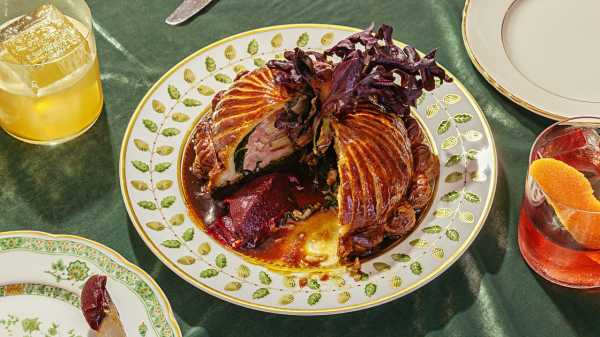
Save this storySave this storySave this storySave this storyYou’re reading the Food Scene newsletter, Helen Rosner’s guide to what, where, and how to eat. Sign up to receive it in your inbox.
One of the most compelling things about Le Chêne, a very Parisian new restaurant in the West Village from the extremely French wife-and-husband team of Alexia Duchêne and Ronan Duchêne Le May, is its lack of interest in playing to any American expectations of Parisian romance and fantasy. Its language, instead, is a chilly French chicness: spiky, refined, offhanded, exuding effortlessness through extraordinary effort. Duchêne and Le May are fairly recently arrived from Paris and worked with a Parisian decorator (the talented Frédérique Mortier d’Aumont) on the design of the dining room, which features creamy whites and jewel tones, heavy cutlery and light-as-air stemware, and is enlivened only by some minor Basquiats and Warhols on the wall. Even the room’s scent, Diptyque Figuier, which wafts from a diffuser tucked discreetly behind a raspberry-velvet banquette, is impeccably Parisian. Servers wear their narrow-shouldered white shirts unbuttoned low enough to reveal an embroidered message on the inside of the placket, furtive enough to not seem clichéd: “Je t’aime.” On all my visits I was struck by how many of the diners at the room’s dozen or so tables seemed to be speaking French.
Duchêne is something of a culinary wunderkind. Six years ago, at the age of twenty-three, she reached the semifinals of the French version of “Top Chef.” She came to New York in 2023, to run the kitchen at Margot, in Fort Greene, where her precise and formal cooking earned praise but proved to be ultimately out of synch with the restaurant’s more casual goals; she left after a month. At Le Chêne, a purpose-built showcase for her talents, her technical skills are on extraordinary display, in that old-fashioned way that feels so fresh right now—call it nouvelle stodginess. I marvelled at the delicate arrangement of tiny sweet shrimp atop a drop of crème fraîche in tartlets the size of euro coins, and at the laborious complexity of a slice of lucullus, an intricate terrine made of layers of foie gras and beef tongue, thin and alternating and innumerable.
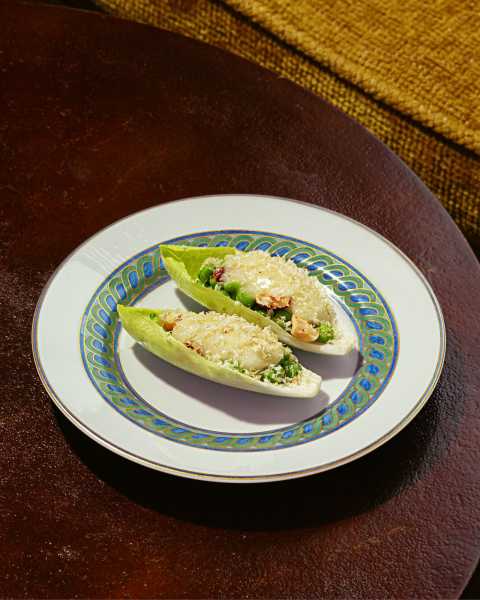
Endive with oyster mayonnaise.
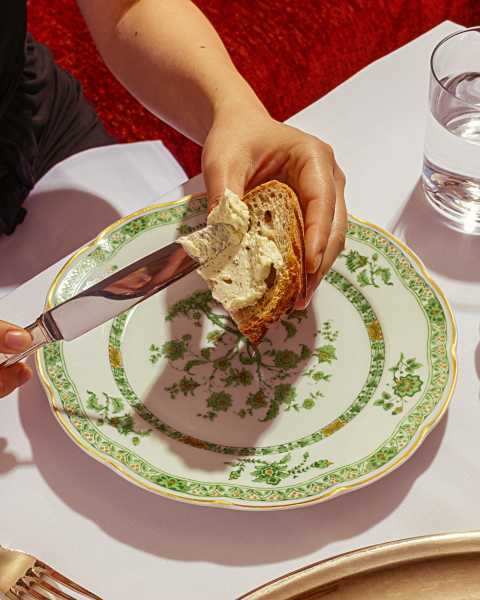
Bread and herb-flecked butter.
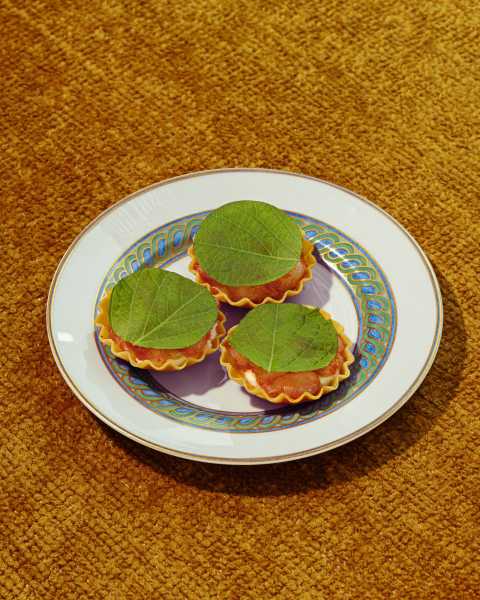
Shrimp tartlets topped with shiso leaf.
What a surprise, and a bit of a heartbreak, then, to find that the beauty of these dishes began and ended with their looks. The whole first half of the menu—the little bites, the meticulously composed small plates—suffered, quite profoundly, from what seemed to be a total lack of salt. The shrimp were slip minus salinity; the terrine all richness, no depth. The same went for batons of “French toast” draped with orange tongues of uni, and for a pale endive leaf filled with oyster mayonnaise and a cluster of pearl-like green peas. Even an opening smear of creamy, herb-flecked butter that accompanied a little golden boule from the French-owned bakery Bread Story, which a server declared to contain sel de mer, tasted like velvet nothingness. This seemed to be no one-off accident—it was a noticeable absence across multiple meals, and went well beyond any plausible kitchen philosophy of subtlety or restraint. The gorgeous dishes, full of potential, remained flat, unactivated. Some restaurant writers have lamented that we’re living in a moment of oversalting, but underseasoning seems to me a far greater crime.
It’s not like Duchêne doesn’t know her way around a box of Diamond Crystal. The back half of the menu, which offers larger dishes such as a lovely fillet of striped bass and a signature pithivier, are seasoned robustly—almost rustically. I felt a bit of whiplash, really, going from the quietude of the opening courses to the roar of flavor in meats thunderously Maillarded, pastry crusts burnished, and sauces as salty as the sea. The pithivier, an enclosed savory pie, is a technical triumph of a dish, its tall crust bearing all the architectural dramatics of a Victorian jelly mold. It’s served sliced in half, revealing a cross section of pink interior featuring interwoven striations of marinated pork and smoked eel, whose flavors merge into an ambient meatiness. Lamb chops, a nightly special, were cooked to perfection but not especially more so than other perfectly cooked lamb chops at other restaurants on other streets.
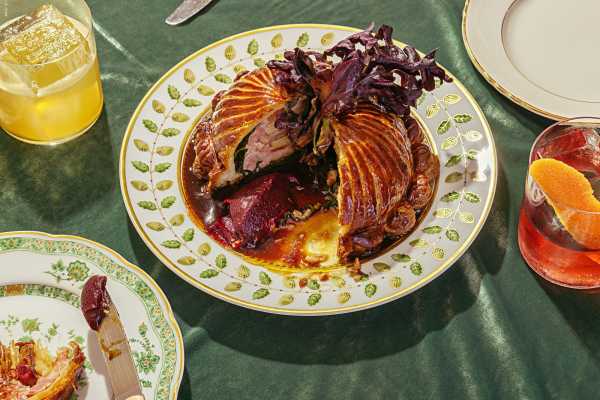
The pithivier, an enclosed savory pie.
I wanted more from Le Chêne, and from Duchêne. Not just more salt but more daring, more challenge, more bold and experimental vulgarity. Her crab thermidor (like many of the dishes that I tried, it’s not currently on the ever-changing menu) was deep and warm with vadouvan but could have pushed harder into heat, into depth, into the sweet crustacean funk of the crab itself. Inside many of Duchêne’s faithful, masterful re-creations of haute cuisine are hints of a nervy brilliance: in a dish of oeufs mayonnaise, the normally ghost-white emulsion was bright green with herbs and topped audaciously with a tumble of tuna tartare. The dish evoked so much: a salade Niçoise, a deli-case handshake of tuna and egg salads, a bit of a tuna-melt twang from shaved curls of Mimolette cheese. It was unexpected, strange, a little awkward, fundamentally genius. There were just a few such revelations, but they made me so happy. A side salad of soft lettuces was tossed in a vinaigrette spiked with a splash of fish sauce, inexplicable, terrific; by contrast, a “beetroot condiment” accompanying the pithivier was, to the molecule, and hilariously, just a very fancy ketchup.
Helen, Help Me!
E-mail your questions about dining, eating, and anything food-related, and Helen may respond in a future newsletter.
Depending on where you’re seated in the room, you can catch a glimpse of Duchêne at the pass of the tucked-away kitchen, her ice-blond hair pulled back, a look of concentration tightening her face as she positions a bit of toast or a garnishing wedge of lime before sending a dish out into the dining area. Quiet and focussed, she seems more interested in the labor of the kitchen than in working the room. She emerges only rarely, perhaps to spoon a sauce over a piece of meat as it’s served, and she doesn’t stay to chat. (In contrast, Le May, who oversees the front of house, often leaves his post at the door to roam the dining room and offer advice and tastes of the menu’s deep list of excellent wines.) I find Duchêne’s seriousness intriguing—despite her television background, her adjacency to fame, her clear determination, she is a cook immersed in the work of cooking. This itself is chic, and to this New Yorker spectacularly Parisian: the intensity, the exactitude, the jagged blades of ambition. Her food just needs a little more salt and a little more sizzle. ♦
Sourse: newyorker.com